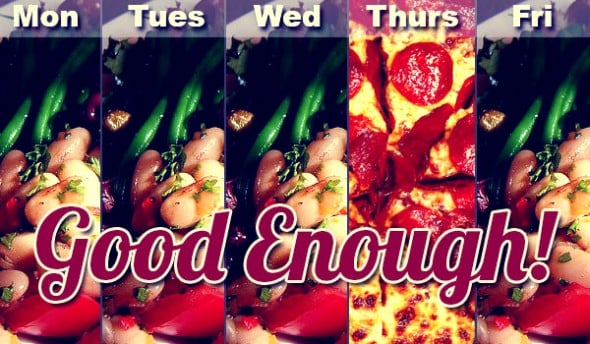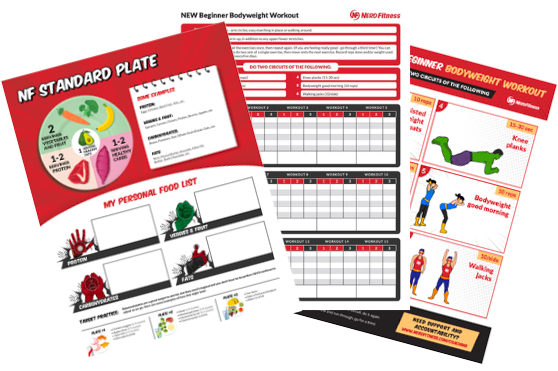
This is a guest post from Thomas Frank.
Have you said any of these things recently?
- “I’ve got eight tests this week, so I’ve decided to only sleep every other night.”
- “We can totally get all of our meals free if we just join every club.”
- “It’s 3:00 a.m. – let’s take the mattresses off of our beds and mattress joust out in the hallway.”
- “YOLO”
If so, you probably fall into the same group of Nerd Fitness readers that I’m in: college students.
For students like me, Nerd Fitness is a gold mine of awesome information and motivation.
Cool workout ideas like parkour? Check.
Sherlock Holmes references? Check.
My favorite video on the internet? Of course.
We students have one area that presents us with a greater challenge than most others face, and that’s eating well.
As I can tell you from three years of experience, it can be pretty darn hard to eat well as a college student.
College just seems to throw up a lot of roadblocks to healthy eating that non-students don’t seem to have to deal with, including super-tight budgets, lack of cooking tools, and ridiculously busy schedules.
I’m going to help you break through these roadblocks. It may be challenging, but despite them all, I know it’s possible. If you’re struggling to figure out how to eat healthier, or you’re worried about WHAT to eat while on a budget, I hear ya.
College can be overwhelming, and knowing when you should be strict with food or more focused on it is tough. That’s why we created two resources to help you.
First, we have our popular 1-on-1 Online Coaching Program (where we work with busy people like you to fix their nutrition in a sustainable, enjoyable way).
And second, we created a free 10-Level Nerd Fitness Diet Strategy guide just for you, because I’ve been in your shoes juggling everything you are juggling.
Download the guide free when you sign up in the box below, then pick the level you’re comfortable with and start leveling up today:
Foundation: The “Doing Good” Mindset

A couple years ago, I read an article in the New York Times about the concept of finite willpower, and the idea has stuck with me ever since. The gist is that exerting willpower to make yourself do one thing will make it more difficult to do other things that require willpower as well. Judging by this recent Nerd Fitness article on willpower, it seems like Steve has come to similar conclusions.
When applied to the strenuous, hectic experience of college, this concept can help manage homework, classes, and jobs. When you’re feeling overwhelmed, it’s easy to lose willpower and turn to cheap, convenient food.
That’s why the key here is to focus on doing good, not on being perfect. It’s almost impossible for anyone to stick to their diet 100% of the time (unless we’re talking about Jack Lalanne here). For those of us in college, the stresses of student life can make it even harder. By focusing on simply doing good, we can make progress towards our goals and avoid being discouraged by one or two cheat meals. Expecting perfection out of yourself is a good way to become susceptible to the “what-the-hell” effect that causes so many dieters to binge.
With that in mind, the foundation of our college-friendly eating guidelines will be the Paleo Diet.
If you’re just starting out I’d recommend simply reading Steve’s paleo guide, and you can download our paleo guide free when you sign up in the box below:
- Discover if Paleo is for you
- The one simple trick to know if your food is Paleo-friendly
- Easy Paleo recipes for beginners to get you started
Basically, these diets are based around eating what our ancient ancestors ate such as meats, fish, vegetables, fruits, nuts, and natural oils. Grains and processed foods (sugar and grease) are not part of the Paleo Diet, so the goal should be to minimize them as much as possible.
Over the summer, I came up with a good set of foods that are close to being in line with them. Remember, as a college student I use the doing good mindset, realizing that it’s pretty hard to be perfect. Here are my staple foods for a great college diet:
- Meats: I tend to use chicken as my primary meat. Why? Chicken is the best quality meat that won’t break the bank. I sometimes buy beef, but the best kind of beef (grass-fed) is really expensive. I also don’t buy much fish, as quality wild-caught fish costs around $15/lb where I live. The cheaper stuff is all farmed fish, which isn’t that great for you.
- Eggs: I go through these like nobody’s business. They’re packed with protein, supply essential vitamins and minerals like choline and selenium, and are great at making you feel full.
- Vegetables: I try to eat a wide variety of veggies in order to get all the nutritional benefits they provide. I prefer carrots, green bell peppers, onions, spinach, green beans, and broccoli.
- Fruits: Apples, bananas, strawberries, and oranges for me.
- White Rice: “Wait, I thought you weren’t supposed to eat grains!” – This is true. However, due to budget constraints, sometimes I eat rice and other grains. Remember, this is about doing good, not being perfect. Plus, after visiting Japan, I fell in love with the food.
- Water and Tea: Calorie-heavy drinks like soda and juice can impede your progress greatly. Try to stick to water and tea as much as possible for the best results. Want your tea to taste awesome? Get it loose-leaf instead of bagged.
These are foods that worked for me, more or less operating under Paleo principles, fitting within the budget and constraints of college, and satisfying my own taste. If you can modify your own eating habits to use this group of foods, you’ll have a darn healthy diet.
However, doing this isn’t always the easiest thing — College can present roadblocks to eating a healthy diet. Let’s look at a few of them now, as well as some strategies for overcoming them.
Roadblock #1: You’re Stuck On a Campus Meal Plan

For the first two years of college, I lived in a dorm and loved it; I had most of my friends living no more than 30 feet away, and it was a 24/7 hangout (although, living in the tiniest dorm ever, I had to build a hanging bed to make it livable).
All throughout this time living in dorms, I was stuck on a meal plan.
While there may be a lot of options offered, much of it won’t meet paleo guidelines or could even vaguely be considered healthy.
So, if you’re living on campus and are required to have a meal plan, is there any hope for you?
I think there is. While you may not be able to eat perfectly, you can get close, and doing good is what really counts. Let’s look at some strategies for getting the healthiest bang for your buck in the dining centers.
Limit Yourself to Only the Good Options
Even though being on a meal plan means you’re forced to eat at a certain place, you’re still faced with an abundance of choice when you enter that dining hall. The key to eating healthily on a meal plan is making the right choices and steering clear of the bad ones.
Here are some solid meal choices I’ve found in my own dining centers:
- Grilled chicken
- Cooked vegetables
- Salad bar (this was my main staple)
- Hard-boiled eggs at the salad bar <– you know, I really like eggs
- Omelettes (breakfast)
- Veggie-heavy stir-fry
Make an effort to learn about all the different food your dining center offers, and start finding some healthy items to start eating regularly. Then, all you have to do is stay away from the bad stuff.
To avoid the temptation of making impulsive decisions at the dining center, let your friends know that you’re eating healthy and that you’re only allowed to get certain foods. Since you probably eat with friends, they’ll be right there to yell at you should you grab for the pizza rather than the grilled chicken.
Also, avoid sitting next to the dessert bar. My friends and I used to sit right next to the ice cream machine during our freshman year – bad decision.
Ask for Dismantled Food
Certain foods you’ll find at the dining centers contain healthy components – but they’re surrounded by junk that you don’t want.
Examples of food with this problem:
- Grilled chicken sandwiches
- Spagetti and meatballs
- Stir fry
Since there are always eighteen hundred billion kids in the dining center at a time, they obviously can’t make all the food before hand. But you can use this to your benefit!
Simply go up to the employee serving the food and ask them for a partial item.
In all probability, they’re required to fulfill requests like this. If not, they usually are nice and give it to you anyway. Use this trick to score stuff like grilled chicken breasts (instead of the whole sandwich) and meatballs (sans pasta). You get to eat healthy at the dining center and you don’t have to waste food!
Get the Heck Outta Dodge
For all the dining-center hacking you can do, you’re still limited in your choices and eventually you’re going to get bored. As a student committed to a paleo-esque diet, you’ll eventually realize that your $3,500 annual meal plan is severely restrictive.
If you’re truly committed to eating well, your best option is to choose a housing option that doesn’t require a meal plan – and preferably one with a kitchen. Having a dining hall as your only option is going to be a pretty big thorn in your side going forward, so look for a way to eliminate it.
A caveat: As someone who acts like they know things about college, I need to stress that you shouldn’t put your financial well-being in danger to escape dining halls. If you have a scholarship or job that requires you to keep a meal plan, then fight the good fight and stick with the dining hall hacks. All things pass in good time.
If you are trying to figure out the above and want to start counting calories or slowly change your diet over the course of your college semester, I got you covered. Pick a level on the Nerd Fitness Diet strategy guide that you’re comfortable with, and then treat each level like a 2-3 week challenge that you have to pass!
Grab your guide when you sign up in the box below and start eating better today:
- Follow our 10-level nutrition system at your own pace
- What you need to know about weight loss and healthy eating
- 3 Simple rules we follow every day to stay on target
Roadblock #2: You Live in a Dorm With No Kitchen

So maybe you’re not required to have a meal plan, but you still live in a dorm room with no real cooking facilities.
Most students in this situation do one of three things:
- Buy a meal plan anyway
- Eat out for every meal
- Eat solely Hot Pockets and Tony’s Pizzas
As you can probably guess, I give all three of these options a big, fat “F” in terms of compliance with our paleo focus. However, I can see why people do these things; not having a kitchen creates a challenge. Here are some things you can do if you’re in this situation.
Find a Place to Cook on Campus
Just because you don’t have a kitchen in your room doesn’t mean you don’t have a kitchen accessible to you.
Many residence halls have community kitchens – either one for every hall or one for the building to share. Sure, they can be a little dirty and ill-stocked, and they might contain a 300 lb passed-out dude with SWAG written on his forehead on the odd Saturday morning…but they’re still usable.
As long as you can get to a stove and sink, you’ll be golden. You can buy your own pans and utensils to keep in your room, and bring them to the kitchen with you when it’s time.
If you can’t find a community kitchen, then the next place to your friends living in apartments. That’s right: it’s time to mooch. In return, you can offer your services as a cook when you come over.
Become a Microwave Ninja
This does not mean training yourself to hide inside your microwave (in fact, that’s a pursuit in which success is actually failure).
Instead, buy healthy food you can make in your microwave. Mini pizzas and frozen taquitos aren’t the only foods designed for microwaving. Better options include:
- Frozen chicken breast
- Eggs (yep, you can nuke ’em)
- Frozen steamer bags of vegetables
- Frozen strawberries and other fruits
Getting all of your nutrition from your microwave might not be the most ideal situation, but you can make it work if you need to.
Roadblock #3: You Don’t Know How To Cook
Alright, so let’s say you’ve finally moved out of your old dorm room. You’ve left the days of trying to sleep through your roommate’s 4:00 AM WoW raids behind and are now standing in your own, brand-spankin-used apartment. With it comes a fully functional kitchen! The only problem now?
When you stand in it, you look like this:

A lot of people tell me they feel like they can’t start a new diet because they don’t know how to cook anything. One of my roommates has this problem – which is why he only eats grilled cheese sandwiches and microwave pizzas!
Don’t be a grilled-cheese-and-pizza person. Learning to cook healthy food actually isn’t that hard, it just takes is a little time to learn and experiment. I used to hate cooking, but after I took a couple weekends of experimenting, I was able to come up with a couple of healthy meals I can make easily.
Today I’m going to share my main meal recipe with you. It’s a stir fry. It’s easy and contains tons of healthy ingredients. Here’s a slideshow I made that shows you the entire process. Since this is a stir fry, you can easily add, subtract, or substitute most of the ingredients without having to worry about it turning out bad.
You can easily experiment with your own ingredients and quantities until you come up with something you really like. That’s why I picked stir fry as a starting place; it’s really easy to customize and experiment with. Another tip – buy an inexpensive wok and make huge batches of this stuff. You can eat one serving and refrigerate the rest. It’s a great technique if you’re super busy and don’t have much time to cook.
If just one stir fry recipe isn’t enough for you, I recommend checking out a couple of these blogs for ideas:
A Word On Drinks

Here’s a list of reasons for wanting to go to the bar that I’ve heard from my friends:
- “I just got done with a really hard test.”
- “Dude, it’s mug night.”
- “Dude, it’s top-shelf night.”
- “Dude, it’s probably gonna be dead at the bars tonight.” (even when it’s not a “night”, it’s a night)
- “I didn’t go last night.”
Make no bones about it (or guts, or ear lobes for that matter) – college and drinking typically go hand in hand. Now, here’s something crazy: even though I’m a college-success blogger writing on a fitness blog, I’m not going to tell you to avoid drinking altogether. Nope.
The trick here (protip: this is not actually a trick) is to not overdo it – as so many students do. The dangers of intoxication aside, drinking is often a pretty calorie-intensive way to spend your time. One beer is usually 100-150 calories, and more drinkers are throwing back more than one at a time.
If you value your health and your goals, make drinking a very small part of your life. Save it for the weekends. Check out Steve’s guide on healthy drinking for more.
The Next Step… Is Yours.
I get it! This stuff is super overwhelming, and just KNOWING what to do isn’t enough. We all know we need to eat more veggies, less sugar, and cut back on total calories.
But time and time again, we find ourselves losing and gaining the same 20 pounds. Or we need to lose 100+ pounds and just can get ourselves to stay motivated enough to make changes stick.
Not to mention: we’re busy, classes are piling up, and life is really stressful right now, NO WONDER we’re overweight and unhappy!
These are the reasons we created our uber popular 1-on-1 online coaching program: specific instruction, expert accountability, and somebody that you can be truly honest with about your struggles with food!
If you want somebody to help you make better food choices, build a FUN workout program for you that fits into your busy schedule, and gets to know you better than you know yourself, we might be a good fit for each other!
You can schedule a free call with our team so we can get to know you and see if our coaching program is right for you. Just click on the image below for more details:
[NEED IMAGE]Still, it’s going to have to be you that initiates the change and starts eating healthily. Remember, you don’t have to be absolutely perfect; you just need to focus on doing good. You’re now armed with the information, so…
Are you going to do something with it?
-Thomas
P.S. – If you still have questions, I’m always willing to help. Hit me up on Twitter or in the comments 🙂
###
Thomas Frank is a senior at Iowa State University and the mastermind behind College Info Geek, a blog that helps students make the most out of college and learn to market themselves better. When Thomas isn’t writing or pretending to study, he’s hacking WordPress, feeding his DDR addiction, and mooching off of Dustin Curtis’ psychology studies. You should follow him on Twitter here.
Photos: greens and beans, pizza, money printing lego guy, drunk guy, dorm room



